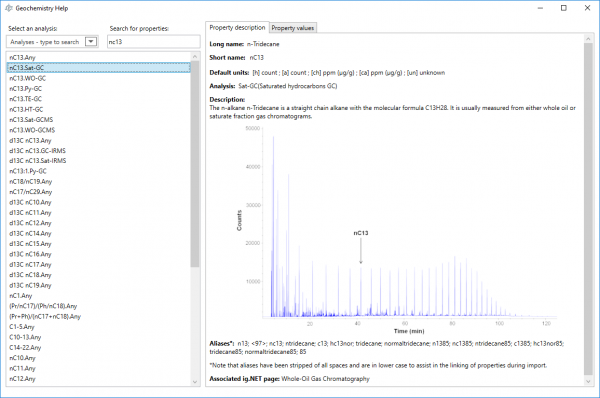The IGI property model
Overview
We have significantly updated the property model (columns) across IGI software (Metis and p:IGI+) compared with p:IGI-3. This page explains some key points and concepts of the IGI property model, and provides a point of navigation to further information.
Usage: Throughout the system, particularly during import and in the property selection dialogues
How to use in practice
Introduction
The goal of the new IGI property model was to create a comprehensive and meaningful database which provides our software users with the ability to record their data and associated metadata while also providing appropriate means for intelligent and efficient interpretation.
The model differs significantly from the p:IGI-3 property model, which was essentially based on a "data grid" where a row was a "sample" and a column represents something that can be measured on a sample, which we call a "property" of that sample.
The IGI property model overview
The new IGI property model extends this concept significantly.
There are some key domain concepts in the IGI property model:
- Wells - strictly these represent a well bore. Unlike p:IGI-3 wells are fully integrated in p:IGI+ and Metis. Wells contain information such location (site information), depths and datums, stratigraphy tops, drilling information and other well-specific properties.
- Samples - represent the concept of a quantity of material (solid, liquid or gas), which will be analysed to measure one or more properties. A sample can be associated with a well, in which case we can use the well information to, for example, convert the sample measured depth to true vertical depth. However a sample can also exist entirely on its own, for example as a seep, grab, outcrop etc. Samples store information on the type of material they are composed of, their collection history and source, and include optional location properties (their site information).
- Analyses. Each sample will typically be subjected to one or more analyses. The type of analysis that is applied to a sample depends on the sample material, the analytical plan and the available budget and equipment. We have an extensive set of analyses supported in p:IGI+ and Metis.
- Properties. Each analysis measures a series of physical / chemical properties of the sample material. Properties range from bulk characterisation of material to highly detailed information on molecular composition.
- Units. Each measurement of a property typically results in a numerical value, which should be given in a specific unit of measure. We support a range of units in p:IGI+ and Metis and automatically convert between units where possible.
Understanding the IGI property model
To effectively use the IGI property model in p:IGI+ and Metis it is necessary to understand the rationale for the design of the model, and to appreciate some of the details of the model. The following pages give information on different aspects of the use of the IGI property model.
- The relation to the p:IGI-3 property model. This explains how the IGI property model relates to the p:IGI-3 property model, and why we have changed the property model significantly in p:IGI+ and Metis.
- Naming in the IGI property model. This explains some of the key concepts in how we name properties within p:IGI+ and Metis, and how to interpret the meaning of the property names. In particular this section introduces the concept of property indicators, which are used with molecular data to indicate whether the measurements are derived from heights, or areas from the chromatogram trace, or have been calculated as concentrations from heights or areas based on the injection of a known mass of an internal standard, or are of unknown origin.
- Units in the IGI property model. This page explains the unit system, and also why ratios are represented separately from units, but integrate with the unit system.
- "Any" properties in the IGI property model. This explains how we have provided a system to simplify the interpretation of the detailed and extensive property model.
There is Geochemistry help available for the property model, which can be accessed from the geochemistry help icon on the extreme right of the main toolbar. The Geochemistry help dialogue is independent of the main p:IGI+ or Metis application and can be kept open at all times for reference.

Video tutorials
None Available
